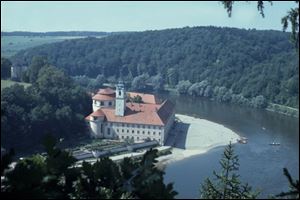
Brew Danube: Abbey is famous for its beer
7/15/2001
The Weltenburg monastery, which stands on the banks of the Danube River in Germany, brews seven types of beer and serves them to visitors.
KELHEIM, Germany - It's a precarious position for the world's oldest monastery brewery, huddled along a rocky bend of the Danube River. But therein lies the charm of Kloster Weltenburg, a sixth-century abbey that guards the west approach to the Danube Gorge, a chasm carved by Europe's second-longest river.
From one of the excursion boats that chugs up the Danube, the view of the high, white-walled abbey with its red-tiled roof is stunning. It emerges, apparition-like, from its hiding place behind a wall of rock and forest, drawing passengers to the ship's rails.
Weltenburg, the oldest abbey in the state of Bavaria, isn't on the well-traveled routes most U.S. tourists take in Germany. But abbey visitors can easily see why the abbot Eustasius set up ecclesiastical shop along the rocky shore around the year 600. And after tasting the malty, dark beer served in the outdoor garden, I'm glad he did.
The river, an ancient travel route, connected towns and their traders along its 1,770 miles. At a time when warring factions cared little about religious affiliations, the monastery's position wedged between river and mountain offered protection.
Today's visitors have an easier time reaching Weltenburg, whose monastic tradition of mixing malt, hops, yeast, and water into a thirst-quenching balm is practiced with religious fervor.
Between March and October, excursion boats regularly ply the two-mile stretch of river that connects Kelheim with the monastery, carrying thirsty visitors searching for the holy grail of abbey beer. Weltenburg, 51 miles north of Munich, is also accessible via a winding highway. But the most romantic and carefree way, my wife, Mary Ellen, and I decided, is to take the excursion ferry.
The relaxing round trip between Kelheim and Weltenburg costs about $5, at 2.20 German marks to the dollar, and includes commentary in German about the sights along the way. Passengers also can sample some of the monastery's seven styles of beer in the ship's lounge to pass the 40-minute trip to Weltenburg
After leaving Kelheim, our boat, the Renate II, began its slow passage along the river between tree-lined banks, fighting the current and barely passing hikers on shore. The footpath and hikers soon disappeared at the approach of the Danube Gorge, whose sheer rock walls squeeze the river through the narrow passage.
Monastic brewing at Weltenburg began about 950 years ago. Since then, the only serious interruption to the process came in the early 1800s, when government authorities confiscated church property. Weltenburg returned to monastic ownership in 1846.
The monastery, which has shouldered its way into an exposed bend of the river, is threatened by occasional spring floods. The river is fed by snow melt and spring rains farther upriver in the Black Forest, source of the Danube.
The floods' legacies are stenciled on the courtyard walls of the leafy beer garden. The worst recent flood to flow into the abbey occurred Pentecost Sunday, 1999, when the Danube swept through the lower floor of the abbey, the restaurant, and its brewery. Even the church, a masterpiece of South German baroque architecture begun in 1714, wasn't spared.
Residents of Kelheim dubbed the deluge “the flood of the century.” The river rose nearly 25 feet above normal, marking the first time in 150 years the not-so-blue Danube lapped against the chapel pews.
Thankfully, neither the church, with its cherubs, angels, pastel frescos, and marble columns, nor the brew house suffered permanent damage.
Brewing is a longstanding tradition as a church activity in Germany. Beer, or liquid bread (remember, beer and bread share the same ingredients), provided the monks with a decent substitute for solid food during their Lenten fast. The first record of brewing at Weltenburg is found in the monastery's “book of traditions” that dates to 1050.
Weltenburg brews range from the pale export beer called Barock Hell, to a full-bodied, dark beer called Asam Bock. (By the way, Hell or Helles is German for a pale beer and has nothing to do with eternal damnation.)
Paul Kottmann, the brewery's technical manager, attributes the “special goodness” of the abbey's beer to the low content of nitrates in the brewery water, its own malt production, and the three months of lagering in stone cellars 130 feet below ground. Kloster Weltenburg beer, incidentally, is available in Toledo at The Andersons.
Visitors with spiritual leanings can ask about staying overnight in one of the 42 rooms at the monastery's St. Georg Inn, where a room runs about $32 a night for a single to $70 for two people. Overnight guests have the opportunity to participate in monastic liturgies and the monk's hourly prayers.
The area surrounding the abbey is rich in brewing traditions. Ingolstadt, home of the Audi automobile 24 miles upriver, is the town where Duke Wilhelm IV issued his famous Reinheitsgebot beer purity laws in 1516. Beer-lovers who want to follow up on that theme can visit a brewery museum, showing the early art of brewing beer. The museum is in a cellar under the castle Hirschberg in Beilngris, located on the Altmuehl River.
The Hallertau region, familiar among brewers worldwide for its aromatic hops, is several miles south of Kelheim around the towns of Mainburg and Siegenburg. Hops, one of the four ingredients allowed in the German brewing process, provide flavoring and help preserve beer.
Some of Europe's earliest settlements are found in the Danube Gorge and lower Altmuehl valley areas. Kelheim's archaeological museum displays artifacts from the Neandertal Man, the Celts, and Romans who wandered the scene long before the monks.